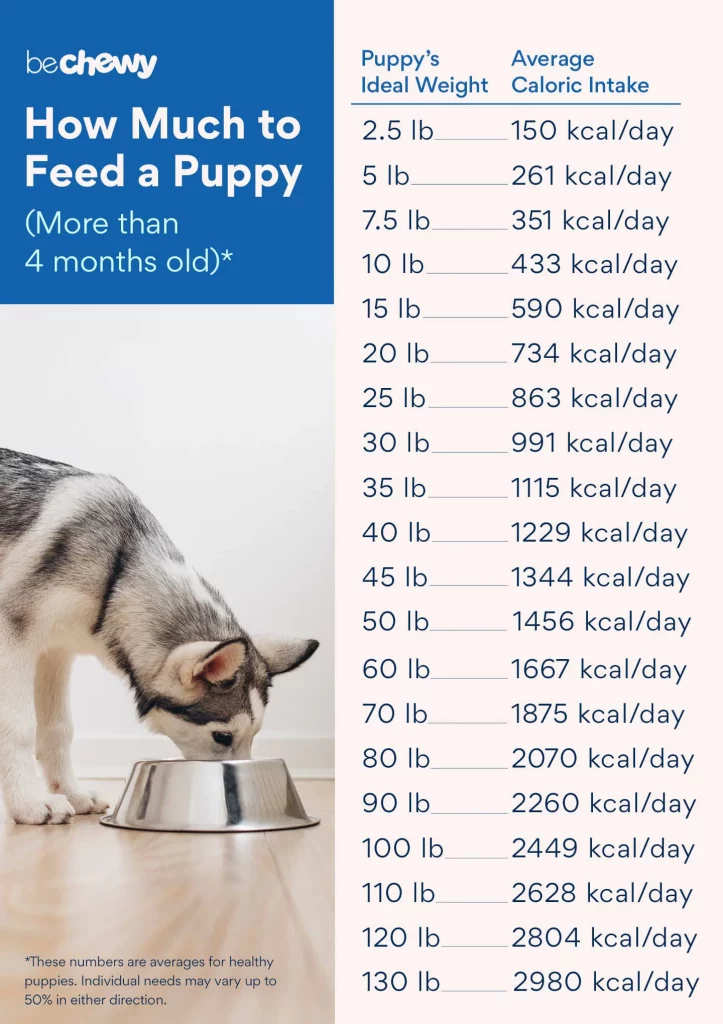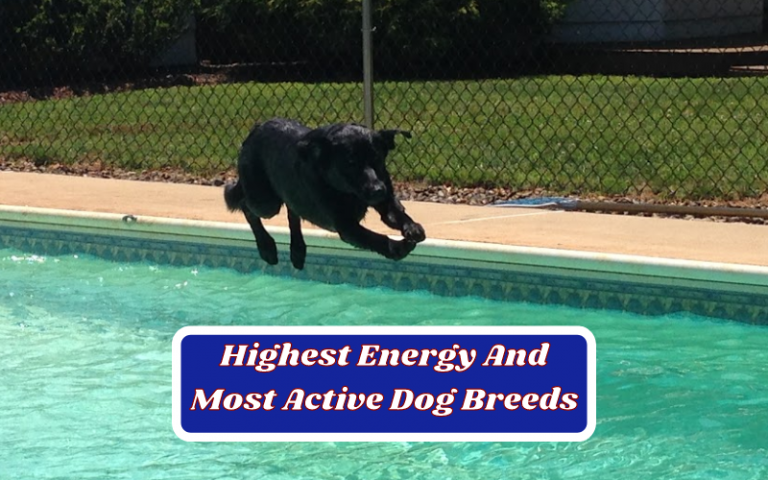Here’s Exactly How Much Puppies Should Eat – Full Guide

When it comes to the health of your dog, there are many factors that will play a role. These factors include giving your dog enough exercise and playtime, and making sure they are eating good, clean food.
But do you know how much puppies should eat? And did you know that the weight, breed and age of your puppy can all play a role in answering that question!
In this article, we’re going to go over the exactly how much puppies should eat as well as when the feeding and schedule recommendations. We hope that our puppy feeding guide will assist you in making sure your growing puppy gets all the nutrients they need.
Ready to get started? Good, let’s go!
What Can Puppies Eat? – A Timeline To Feeding Your Puppy
0-3 Weeks: Puppies should be with their mother and they should be nursing during these times. The mother’s milk contains important nutrients needed to give puppies a healthy diet and prevent them from illnesses. You don’t need to worry about how much to feed puppies during this time because their mother will take care of their nutrition needs, and unless you’re the owner of the mother who gave birth, you will not be involved here.
3–4 weeks: Puppies start to wean themselves off of their mothers’ milk and start developing teeth at this time.
A flat saucer can be used to mix canned wet puppy food and a milk substitute (about half and half or a 50:50 ratio.) The milk substitute can then be gradually reduced until only puppy food is given to the puppy. If the puppies don’t take to the new food right away, there’s no need to worry. The new formula may require a few days to adjust to. To ease the transition, gently rub the puppy’s mouth and nose with your fingers after dipping them in the mixture.
4-6 Weeks: Puppies should have completely switched over to puppy food by this point.
6-12 Weeks: It is critical that puppies are fed puppy food. Puppy food is crafted specifically for puppies. The diet designed specifically to meet there nutrient requirements and allows them to grow big, strong and healthy development.
Giving your puppy adult food will deprive it of vital nutrients. Usually, four feedings a day are enough to meet the nutritional needs of a puppy.
12-36 Weeks: During this time, your puppy should be eating puppy food. They should not be eating adult food yet. Continue to feed your puppy, food that helps meet their nutritional requirements.
6–12 months: Depending on your dogs breed, you may begin to gradually start introducing adult food to your puppy. This will depend on your dogs breed however. Small breeds can transition from 7-9 months, while larger breeds at about 12 months. I always like to say, it is better to start to late here, then too early (meaning don’t rush this!) To make sure your dog is getting all the nutrients he needs as a growing dog, it doesn’t hurt to keep him on puppy food longer than is necessary.
1 Year: By this time, most dog owners are about to switch or have switched their puppy to adult food.
Exactly How Much Puppies Should Eat By Weight
When it comes to feeding puppies, the portion sizes should be determined by your dogs body, there breed, and metabolism. All breeds have different nutritional needs. Don’t worry if your puppy occasionally refuses to eat or skips meals. It might indicate that they are ready to stop eating or that you gave them too much food. If this happens, slowly cut back on the serving size.
In order for your puppy to learn when to expect with their food, it is crucial to establish a routine for his feeding schedule.
4-16 Weeks: At this age to meet their nutritional requirements, young puppies require three-four meals everyday. For the exact amount of food per serving, you will need to do a little math (don’t worry!) Just divide the amount of meals you plan on giving your dog, by the amount of total calories they should be eating a day (this number will vary depending on the weight of your dog.) See the chart above for more info.
For example: A 12 Week old, 30LB dog should be getting around 1500 kcals/day. If your puppy food is 300 kcal per cup. That would mean your dog would need 5 total cups.
How did I get this number?
1500 total kcals needed- take that number and divide it by the amount of calories in your dog’s food. Here it is 300. This gave us 5. Which means your dog will need 5 cups of this food a day. Take that number and divide it by the amount of meals you plan on giving your dog. For 3 meals a day that would be about 1.67 cups of food per meal.
Now What about dog’s older than 16 weeks?

4+ Months: You can cut back on the number of feedings to twice daily as your puppy get’s a little older. Depending on how active your dog is, will also play a role in how much your feed them. More active dogs, will need a lot more calories.
Use the same example as above.
How Often to Feed Your Puppy

Puppies require numerous small meals of food designed specifically to meet their unique nutritional needs each day.
Puppies should be fed three to four times per day, so if you are currently giving your puppy ¾ of a cup of puppy food twice daily, you might want to consider spreading it out by giving it ½ cup three times per day.
For the puppy, smaller meals are easier to digest, and frequent meals cause energy levels to fluctuate less dramatically. To reduce the risk of gastric dilatation volvulus, I would advise sticking with a 3–4 times a day feeding schedule if at all possible for your dog, who is a mixed large breed dog. You may start feeding twice a day at around six months of age for convenience.
Puppy Feeding Schedule
Puppies typically eat three times a day, and depending on your schedule this may vary. For example a good example of this is feeding once at 6-8 am, 12-1, and 5-6 pm. There is no set way of doing this and you can modify your schedule for puppy eating times as necessary if you decide to do more than three feedings. Make sure to schedule the final feeding for not much later then 6:00 p.m. This is so your puppy will have plenty of time to digest the food and then go to the bathroom before bedtime.
Puppies And Avoiding Overeating
Having an active dog allows for more wiggle rom on this, as they will be burning more calories all day. To avoid overeating though, it is important to make sure you are aware of how much they should be eating based on there size and age, portion control is essential.
Can Puppies Eat Adult Dog Food?
No, you should not feed your puppy adult dog food. Dogs of different ages require different nutrients. Puppies need more protein, micronutrients, and carbohydrates to help them develop into adult dogs. In order to help them grow, puppies also need a lot of calories, so it’s crucial to buy your puppy a premium food brand.
Puppy food is typically smaller than adult kibble because a puppy’s mouth is smaller than an adult dog’s mouth. It can be dangerous and harmful to feed adult dog food to puppies because of these reasons. Giving an adult dog food to a puppy can harm its teeth, jaws, and general health, and should be avoided.
Dry Food, Wet Food, Or Both For A Puppy?

Many pet food manufacturers have collaborated with experts in canine nutrition to create unique formulas that meet all dogs unique requirements.
The most expensive type of food to feed your puppy is canned food. Puppies and dogs like wet food, and it usually taste better.
The most affordable option is kibble, and the major producers provide a complete and balanced diet for dogs of all shapes, sizes, and ages. Dry food can be fed in its original form straight from the bag.
Foods to Avoid
Foods that list corn or meat by-products as the first ingredient should be usually not the best. Protein should always be the first listed ingredient of your dog’s food’s first five ingredients. Dogs are omnivores, so both plant and animal sources of energy and nutrients are consumed by them. However, protein is necessary for the growth of their muscles and connective tissues, a healthy immune system, energy, and strong skin and nails.
You want to make sure the food you buy is high quality and is loaded with good proteins, fats and carbs. You want to avoid things like “all meat.”
How to Switch from Puppy Food to Adult Food
You should make the transition from puppy food to adult food gradually over the course of week. Do not go cold turkey or have an abrupt change in your dog’s diet as this may upset their stomach.
Following the below guide is a good way to do this:
| Transition Schedule | Old Food | New Food |
| Days 1 and 2 | 80% | 20% |
| Days 3 and 4 | 70% | 30% |
| Days 5 and 6 | 50% | 50% |
| Days 7 and 8 | 30% | 70% |
| Day 9 | 10% | 90% |
| Day 10 | 0% | 100% |
By following a guide like this, your dog will be able to transition from his old food to his new food in a safe and effective manner.
Feeding Your Puppy Table food & Junk Food
Feeding your dog table food or scraps is not the best thing to do, but we understand how it is sometimes hard to say no to our furry friends. The best advice I would give here, is to train your dog to go lay down inside when you’re eating.
By doing this when your dog is a puppy, they will get use to it (trained) to know when you are sitting down and eating, they will need to be inside sleeping or resting. Now trust me, this will be hard at the start. You will have to get up frequently while you’re eating to correct your puppy a lot.
But trust me, once your puppy learns this (and it wont take long) it will make an amazing trait. Your dog will be much healthier as they wont be eating junk food, (most of our table food, is junk food for them, excluding things like plain chicken, plain fish, etc) and they won’t be begging for food.
Now in rare occurrences you may give them a piece or some of your table food. But this should be done when you give an order to your dog, such as come.
Must Knows For Your New Puppy
Your dog may or may not have had any serious health issues when they were a puppy. Since pre-existing conditions are not covered by pet insurance companies, the younger your dog is when you enroll him, the better coverage you will probably get for the duration of his life.
Additionally, pet insurance can assist you in maintaining your financial stability during the erratic puppy years, when dogs are more likely to ingest dangerous objects and encounter hazardous situations. For more information on what pet insurance is and to decide whether pet insurance is worthwhile for your puppy, see our guide to pet insurance.
Conclusion
There is no one exact way to feed your puppy and when it comes to the question of how much puppies should eat, well that varies.
Knowing how to evaluate your dog’s body will help you decide how much food to give them.
The advice given on the labels is only intended as a general guide and may not apply to all dogs. Depending on your dog’s condition, how active they are, and how old they are, you might need to feed a little more or a little less.
Always make sure it is the right time to transition your puppy from puppy food to adult food. And keep in mind that a dog whose nutritional requirements are met will be happier and healthier as a result.
We hope you were able to learn exactly how much puppies should eat, what your puppy should eat, and everything in between. Remember, at Jacktra our mission is to give hope to all the dogs out there who may be abandoned or who are stuck in a shelter. Every time you use our site, interact with our site, and search with us, we’re able to help those millions of dogs in need.





